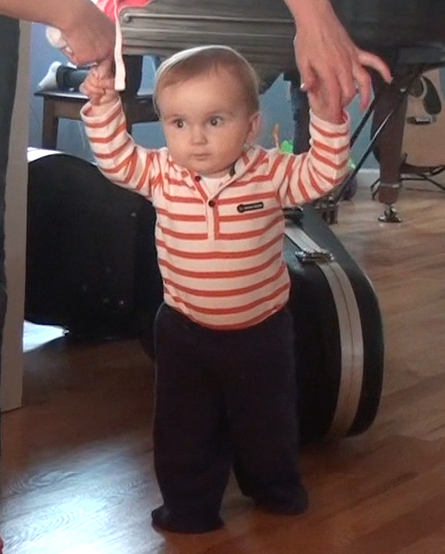
- All babies are different and she will take that first step when she is good and ready. It typically happens between nine and 15 months, but if your baby is on the later side, don’t worry. Crawling is an important milestone that helps build strong core muscles and a great foundation for future development. There is nothing wrong with an extra month or two of crawling.
- Exersaucers and jumpers do not teach babies how to walk. Babies need lots of free movement to learn to walk as the walking milestone builds on crawling and sitting unsupported. Allow as much free movement as possible.
- Barefoot is best. She will have better control as she learns to walk if she is barefoot because her tiny toes can grip the floor and the sensation of the floor on her feet will help her feel more secure.
- It takes a lot of coordination to learn to stabilize one leg while lifting the other leg. He will look
 very stiff when he first starts to walk until he figures out how to relax certain muscles and contract others to make everything work together.
very stiff when he first starts to walk until he figures out how to relax certain muscles and contract others to make everything work together. - Your baby’s personality plays into how early she will walk. If she is very cautious, it may take her a little longer to get up the courage to give it a try, whereas a baby who is more of a risk-taker, may attempt walking earlier.
- It takes a lot of courage to walk and some babies might need a lot of encouragement. Praise every attempt and show him that you are there to support and catch him when he falls.
- Most babies alternate between walking and crawling. If he sees a toy he wants that is across the room, he knows it is quicker to drop to his knees and crawl there. It is not a regression, it is efficient!
- It can be hard to stop, once your baby starts to move forward. Babies don’t bend their knees and walk heel-toe like we do, they walk with a more stiff posture, so it is more difficult to stop if she is going quickly because each step has more force behind it. They will probably just fall down. You can be there to cushion the fall.
- Some babies toe-walk at first. Try to discourage walking on tip toes all the time. If they occasionally go up onto their toes, that is fine and even good for the muscles of her feet and legs, but toe walking all the time is an abnormal pattern. Try to discern if he dislikes the sensation of the carpet on his feet and if that is the case, put socks with grippers on him. If his calves are too tight to allow him to walk with flat feet, consult your pediatrician. Sometimes babies are just nervous and their muscles tighten and he automatically goes onto his toes. Stay nearby, offer a lot of reassurance, and try to keep him calm.
- A whole new world opens up to your baby with that first step. They are suddenly much more independent and she is becoming a toddler. This is a huge transition that can be celebrated!
References:
American Academy of Pediatrics https://www.aap.org/en-us/Pages/Default.aspx
World Health Organization http://www.who.int/mediacentre/infographic/new-born/en/
Center for Disease Control https://www.cdc.gov
American Journal of Occupational Therapy https://ajot.aota.org
American Occupational Therapy Association. https://www.aota.org
Fox, S. (1999). Baby Steps: Exercises of Baby’s First Year of Life. Berkley Publishing Group.
Kliegman, R., Marcdante, K., Jenson, H. & Behrman, R. (2006). Essentials of Pediatrics, Fifth Edition. Elsevier Saunders.
Leach, P. (1997). Your Baby & Child. Random House.

